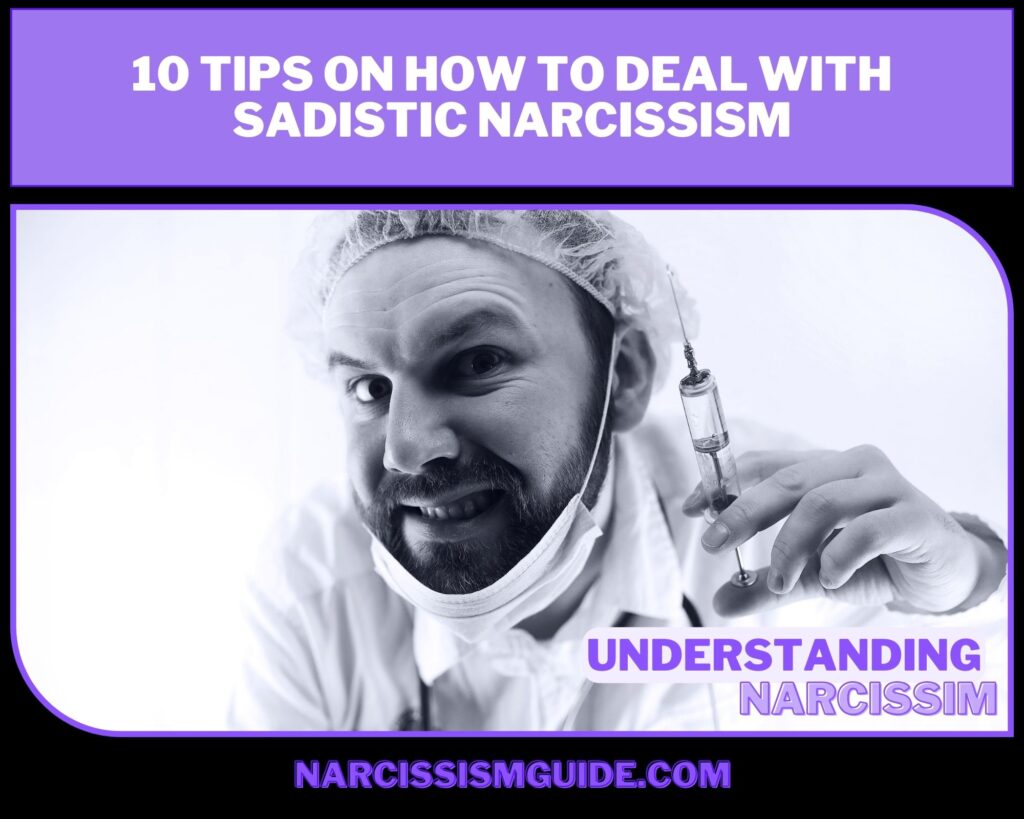If you’ve ever been in a relationship with someone who seemed to enjoy causing you emotional or physical pain. You may have encountered a sadistic narcissist1Guyonne Rogier (2023) Pathological narcissism and sadistic personality.
This personality disorder can be incredibly challenging. But there are ways to protect yourself and regain control of your life.
Understanding how to deal with this personality disorder is the first step in protecting yourself and moving on from a toxic relationship.
In this blog post, we’ll explore what sadistic narcissism is and provide tips on handling them.
What is a sadistic narcissist?
A sadistic narcissist is a person who exhibits both Narcissist Personality Disorder2E. Ronningstam (2016) Narcissistic Personality Disorder and sadistic personality traits.
An inflated sense of self-importance characterizes narcissism. A need for admiration and attention and a lack of empathy for others. On the other hand, Sadism is characterized by taking pleasure in inflicting pain or humiliation on others.
A sadistic narcissist may benefit from dominating, controlling, or manipulating others. They may have a grandiose sense of entitlement and demand that others cater to their every need.
They may enjoy causing emotional pain, physical harm, or humiliation to others. Especially those they perceive as weaker or vulnerable.
Sadistic narcissists can be manipulative and charming. They use their charisma to manipulate and control others. They may use their victims for pleasure or gain, with little regard for their feelings or well-being.
They may also be prone to extreme anger or rage when their sense of entitlement is challenged. They feel they are not getting the attention or admiration they think they deserve.
When these two traits coexist in an individual, it can result in a particularly toxic and dangerous combination. It is crucial to seek help and protect yourself from further harm if you are in a relationship with a sadistic narcissist.
Can a narcissist also be a sadist?

Yes, a narcissist can also be a sadist 3Xanya Sofra (2020) The Dark Reflection of Sadism within the Brilliance of the Narcissistic Personal. Sadistic behavior involves deriving pleasure from causing others pain or suffering. It can manifest in various ways, including physical, emotional, and psychological abuse.
Narcissists, who have an inflated sense of self-importance and lack empathy, may engage in sadistic behavior to assert their power and control over others.
It can be particularly damaging in relationships, where the narcissist may use sadistic tactics to manipulate and abuse their partner. It’s essential to recognize the signs of sadistic behavior and seek help if you are in a relationship with a narcissist who exhibits these tendencies.
What are the four types of narcissists?
#1: Grandiose narcissist
Grandiose narcissism is also known as Agentic or Overt narcissism. A grandiose narcissist is a person who thinks very highly of themselves and considers themselves to be better than others.
They have a strong need for attention and admiration from others, and they often feel entitled to special treatment. Grandiose Narcissist may become angry4Aidan G.C. Wright (2017) The Effect of Pathological Narcissism on Interpersonal and Affective Processes in Social Interactions when someone disagrees with them.
They may fantasize about being incredibly successful, influential, or attractive and constantly seek validation and recognition for their accomplishments. Overall, they have an exaggerated sense of their importance and expect others to treat them accordingly.
#2: Vulnerable narcissist

Vulnerable narcissism is also known as Closet or Covert narcissism. A vulnerable narcissist is a type of person with narcissistic personality traits who has an underlying sense of insecurity and inferiority.
They may come across as shy or withdrawn, but they still need attention and admiration from others.
They tend to feel that they are special and unique and may harbor fantasies of being more successful or influential than they are. However, they are susceptible to criticism and rejection and may react with defensiveness or aggression when their sense of self is questioned.
In general, they are more fragile and emotionally sensitive than grandiose narcissists. Their behavior may be driven by a fear of being seen as inadequate or unimportant.
#3: Malignant narcissist

A malignant narcissist is a type of narcissist who combines traits of grandiosity with Sadism.
They take pleasure in causing harm to others and may engage in manipulative or abusive behavior to achieve their goals.
They often have a sense of entitlement and lack empathy for others. They may disregard other people’s feelings or rights and often lack empathy.
Malignant narcissists can be highly dangerous as they exhibit antisocial or criminal behavior. Such as lying, cheating, or stealing. Recognizing the signs of a malignant narcissist and protecting yourself from their harmful actions is important.
In general, they are willing to go to great lengths to achieve their goals, even if it means hurting or manipulating others. Their behavior can be dangerous and harmful to those around them. It is essential to be cautious and protect oneself when dealing with a malignant narcissist.
#4: Communal narcissist

Communal narcissists5Ziyan Yang (2018) Communal Narcissists present themselves as selfless givers. But their motives lie in their need for admiration and attention.
They may donate large sums to charity or volunteer frequently, seeking public recognition for their good deeds.
For example, a communal narcissist may donate money to a charity and then brag about it on social media. Seeking praise and admiration from their followers.
What is a sadistic abuser?

A sadistic abuser is a person who derives pleasure from causing pain and suffering to others. Whether physical, emotional, or sexual6Sam Vaknin (2021) Sadistic Abusers. This type of abuser may enjoy manipulating and controlling their victims. They use fear and intimidation to maintain power over them.
Sadistic abusers may physically abuse their partner while emotionally manipulating them into thinking they deserve the abuse. They may enjoy their power and control over their partner and get pleasure from causing them pain. They may also enjoy seeing their partner in fear or distress, giving them a sense of superiority.
The sadistic aspect refers to their pleasure in causing harm. While the term “abuser” indicates that their behavior is ongoing and causes damage to their victims. It is important to note that sadistic abusers are often highly skilled at manipulating their victims and may be adept at hiding their true intentions from others.
Victims of sadistic abuse may struggle to leave the relationship due to fear or the abuser’s manipulation tactics. Victims need to seek help and support to leave the abusive situation safely.
How to deal with sadistic narcissism? 10 Tips
If you’re dealing with a sadistic narcissist, it can be highly challenging.
It’s hard to know how to handle sadistic narcissism. Because in every abusive situation, your gut tells you what to do, but your brain keeps telling you that if you follow that advice, it will only hurt you more.
When it comes to dealing with a sadistic narcissist. No one tells you how to deal with these types of people because the truth is too hard for most people to handle. These are some tips on how to get through this in the healthiest way possible.
#1: Recognize the signs

Recognizing the signs of sadistic narcissism involves understanding the traits and behaviors associated with this personality disorder.
By familiarizing yourself with these characteristics. You can identify when someone is exhibiting these patterns and take steps to protect yourself from their harmful effects.
Some common signs of sadistic narcissism include a need for power and control over others, a lack of empathy or concern for other’s feelings, and a tendency to derive pleasure from causing pain or humiliation.
It is essential to recognize these warning signs to establish healthy boundaries and protect yourself from emotional or physical harm.
#2: Set boundaries
Setting boundaries is essential when dealing with individuals who display traits of sadistic narcissism. Establishing clear boundaries and communicating them effectively to the person is vital. It means being firm in your expectations and not allowing them to push past those boundaries.
For example, If you have a friend who constantly puts you down or belittles you. It may be necessary to establish a boundary that you will not tolerate that behavior. If they continue to violate that boundary, they may be required to distance themselves from that person.
Remember, setting boundaries is not about punishing the other person but protecting yourself and your emotional well-being. It is a way to ensure you are treated with respect and dignity in your relationships.
#3: Avoid playing into their games

Sadistic narcissists may use manipulation tactics like gaslighting to control and confuse their victims. It is essential to recognize these games and avoid playing them to protect yourself.
By staying grounded in your reality and setting clear boundaries, you can minimize the effects of their toxic behavior.
If a sadistic narcissist tries to blame you for their actions or twists your words, don’t fall for it. Instead, calmly assert your perspective and stand firm in your truth. Remember that their games are designed to make you doubt yourself, but you don’t have to let them win.
#4: Why seeking emotional support is key
When dealing with a sadistic narcissist, seeking support from trusted individuals can protect your well-being.
Friends and family who have your best interests at heart can provide emotional support and help you stay grounded in reality.
Seeking guidance from a therapist or counselor trained in dealing with narcissistic abuse can offer you practical tools and strategies to cope with the situation and make informed decisions about moving forward. It is important to remember that you do not have to face the problem alone and that seeking support is a sign of strength.
#5: Keep a record
Keeping a record of abusive or manipulative behavior can help identify patterns and clarify the situation.
This record can also serve as evidence if legal action needs to be taken. It is essential to document specific incidents, including dates and times and how they made you feel.
It can be done through journaling, recording conversations, or even saving emails or text messages. Having a record can also remind you why it’s crucial to set boundaries and protect yourself from further harm.
#6: Focus on self-care

Focusing on self-care can be a powerful tool in protecting yourself from the harmful effects of a sadistic narcissist.
It can include engaging in activities that bring you joy. Practicing mindfulness or meditation, getting enough sleep and exercise and seeking therapy or counseling.
You can build resilience and maintain stability. Even amid challenging situations by prioritizing your well-being.
#7: Avoid reacting emotionally
Sadistic narcissists often seek emotional reactions to maintain control and power over others. They may intentionally provoke or manipulate to elicit a response.
By avoiding emotional reactions. Individuals can take away the narcissist’s power and maintain their emotional well-being. It can be done by staying calm and rational, setting boundaries, and focusing on self-care.
#8: Stay calm and assertive

It’s essential to remain calm and assertive. It can help you avoid paying for their manipulative games and maintain control of the situation.
By staying composed and confident in your interactions with them, you can avoid giving them the satisfaction of seeing you become emotional or flustered. It can also help you set clear boundaries and assert your needs and values in the relationship.
#9: Seek professional help

Seeking professional help from a therapist or coach specializing in narcissistic abuse can be essential in healing and moving forward.
A trained professional can help you process your experiences. Identify any patterns or beliefs contributing to the abuse. Develop coping strategies to navigate the relationship better or decide to leave.
They can also guide on setting healthy boundaries, managing emotions, and rebuilding self-esteem.
#10: Consider ending the relationship
This tip refers to the importance of considering ending a relationship with a sadistic narcissist if the situation becomes too harmful or dangerous for one’s well-being.
Sometimes, setting boundaries and seeking support may not be enough. Leaving the relationship may be necessary for one’s safety and mental health.
This decision should not be taken lightly and may require the guidance and support of a professional to ensure a safe and healthy transition out of the relationship. It’s important to prioritize one’s well-being and safety when dealing with a sadistic narcissist.
Final Thoughts
Dealing with a sadistic narcissist can be overwhelming and frightening, but it’s crucial to remember that you are not alone.
By seeking support from trusted individuals, such as friends, family, or a therapist, you can protect yourself and find the strength to break free from their harmful influence.
Remember that you deserve to be treated with respect and kindness. Don’t let a sadistic narcissist control your life or undermine your self-worth.
By recognizing the signs of their behavior and taking action, you can take back your power and find the happiness and fulfillment you deserve.
